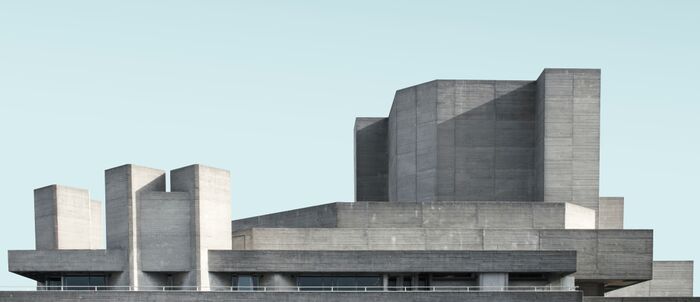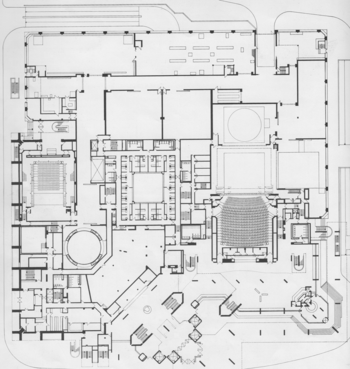The role of the theatre consultant emerged in the 1960s and 1970s, meeting the need for expertise both in the rapidly changing technologies of theatre production, and the innovations being made in the design of performance spaces.
In the middle years of the 20th century, the young Richard Pilbrow (Q435) was passionate about theatre. He later wrote: my number-one ambition was to be a stage manager. I had read everything I could find by Edward Gordon Craig … he foresaw a theatre of the future that was to be a new art form, primarily the creation of the director, whom he termed the ‘stage manager’ and defined as ‘a master of the art and science of the theatre.’ (Q30492, 11) He went on to begin a career in lighting design in the 1950s, at a time when the role of lighting designer was almost non-existent. To get work, Pilbrow bought some old lights, so he could hire the equipment out to producers, and also offer his services to light the show. This was the beginning of Pilbrow’s company, Theatre Projects – the name a signal of his continuing ambition to be in control of all aspects of theatre-making, not only lighting.
Theatre Projects (TP, Q29724) proved to be highly successful. The lighting hire and design business expanded, soon TP moved into the rapidly developing area of theatre sound. Pilbrow also began some consultancy work on new theatres, first for the Gulbenkian Centre at the University of Hull (opened in 1969), and then for some of the many new theatres being built as part of the Arts Council’s ‘Housing the Arts’ programme; a new division of TP had come into existence.
When a new, purpose-made building for the UK’s National Theatre (NT, Q9343) was being planned, Pilbrow was asked to consult on the stage lighting systems. The new building was very ambitious, with three different auditoria, and demanding technical requirements. Pilbrow joined a team of experts who advised and guided the development of the technical facilities at the NT – lighting, sound, acoustics and stage engineering. Over time, TP’s theatre consultancy separated from the other parts of the business, and expanded its operation globally – at first in the United States, and then elsewhere. Today it has offices in London, New York, Paris, Denver, Shanghai and New England, and works not only on the design of theatres, but also concert halls, exhibition spaces, museums, galleries and places of worship.
Richard Pilbrow and his colleagues at Theatre Projects set the template for the theatre consultant. Theatre experts had previously advised on how best to meet the technical needs of theatres, but TP was central to the establishment of the theatre consultant as a distinct professional role. The ever-increasing complexity of the technologies used in theatres has driven the need for such experts, but so too has an increase in the expectations of audiences, producers and funders. Theatres are unusual buildings, with very specific requirements, and poor design decisions can cost money unnecessarily, limit the scope of what is creatively possible in the building, and degrade the audience’s quality of experience through poor sightlines, uncomfortable seats, uncontrolled temperatures (too hot or too cold), and long queues for the toilet at the interval.
Most architects only build a small number of theatres and may win the role of designing a prestigious project through a competition, judged by people who themselves know little of what is involved in making a successful theatre. Theatre consultants therefore play a key role, acting as a bridge between the client, the architect and the contractors building and fitting out the theatre.
They provide a wide variety of services, depending on the project. As well as advising on the technical facilities, theatre consultants will often help with the auditorium design: sightlines, aesthetics, and audience experience, plus technical issues, such as heating and ventilation, fire regulations, emergency evacuation, and access requirements.
In some cases, theatre consultants will be involved in the early stages, helping develop the project’s concept, starting from the initial brief, and going on to support fund-raising and planning permission through visualisations and cost estimates. They may also advise on the refurbishment, renovation and re-purposing of existing buildings, and conservation issues in older buildings.
In his autobiography, Pilbrow wrote: In the late 1960s, I did not know the paramount importance of emotion and intimacy; I did not understand that, in a theatre, it is not enough to see and hear. Our audiences must feel … Theatre architecture must pull us all together. (Q30492, 231) Theatre consultants have a vital role in ensuring theatres meet the physical needs of the spectators and are effective functional machines for mounting productions. Above all, though, they are experts in working with all those involved to make spaces where audiences will have the powerful, shared experiences that live performance can create.

